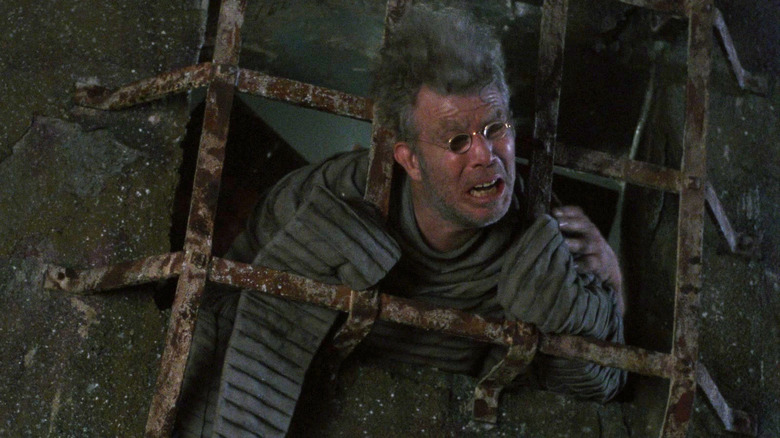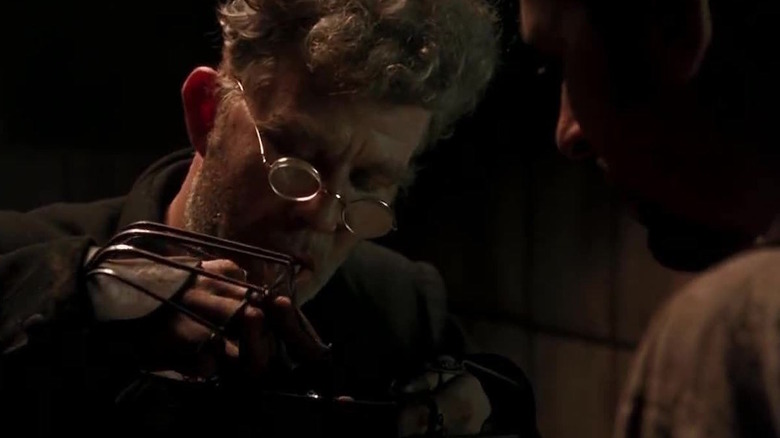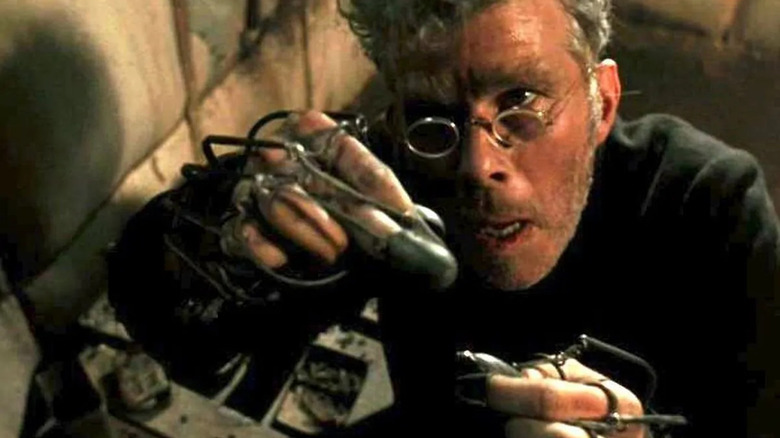Before Nicholas Hoult, Tom Waits Ate Bugs As Renfield In Bram Stoker's Dracula
Bram Stoker's 1897 novel "Dracula" is told in epistolary form, and begins with the character of Jonathan Harker trekking into the Carpathian Mountains to close a real estate deal with a mysterious, elusive Eastern European count. The Count, a small smiling bald man with a mustache, is none other than Dracula, an ancient vampire that feeds on human blood and is in league with Satan. Dracula signs the paperwork, locks Jonathan in his dilapidated castle with a trio of succubi, and takes a ship to England. Jonathan will eventually escape to Budapest, but Dracula is still at large, ready to infiltrate England.
Later in the novel, it will be revealed that Dracula has been psychically convening with a local mental patient named Renfield, currently locked up in a British asylum. Dracula will use Renfield to infiltrate homes and drink his victims' blood. Renfield's role in Stoker's novel is relatively small, but was expanded in Tod Browning's 1931 film adaptation. That film opened with Renfield (Dwight Frye) falling under Dracula's spell in the Carpathians, and accompanying him to England on the H.M.S. Demeter. The entire first act of Browning's film was devoted to the relationship between Renfield and Dracula, and Frye was permitted to mug, grin, and generally be an amazing, sniveling monster.
In both versions, Renfield, inspired by Dracula's thirst for human blood, ate bugs and vermin to increase his own life force. It was the Frye version of Renfield that most pop audiences know and was the most likely basis for Nicholas Hoult's version of the character in Chris McKay's new film, "Renfield." But while Frye may have defined the character, we would be remiss to forget about the wild Renfield performance Tom Waits gave in Francis Ford Coppola's notorious 1992 film adaptation, "Bram Stoker's Dracula."
But is it good?
Given the wild, rococo nature of Francis Ford Coppola's film, it's difficult to discern if it is a "good" film or not. Some audiences may respond to its over-the-top, semi-surreal theatricality, wild editing, and monstrous special effects. Others may be put off by the film's utter chaos, seeing it as a sneeze of weird-ass ideas splattered haphazardly across the screen. "Bram Stoker's Dracula" exists on a matrix that somehow overlaps the glorious fable-like qualities of Paul Leni's "The Man Who Laughs" with the clunky, hip energy of 1990s MTV. For better or for worse, there are few films like it.
On the MTV side of "Dracula," legendary musician and anthropomorphic whiskey-filled ashtray Tom Waits played Renfield as part eccentric scientist and part ... Peter Lorre? It's difficult to tell exactly what Waits is going for with Renfield. He stares out his cell window and monologues to an unheard Dracula about how he has always done his master's bidding. In a later scene, Dr. Seward (Richard E. Grant) goads Renfield into admitting he likes to eat bugs. And, if bugs are on the menu, why not rats, or even cats? Waits wailing about how pleased he would be to eat a cat is one of those formative cinema experiences that can leave a mark on a young child.
Like everything in Coppola's film, Waits' performance is unreal and expressionistic. Waits is not delving deep into the psychology of his character, but acting out a rendition of Renfield that lives only in the realm of aesthetics. Renfield's strait jacket looks like he has been wrapped in disused concertinas. This is clearly not the real world. Incidentally, Eiko Ishioka, the film's costume designer, won an Academy Award.
Renfield's finger appliance
Tom Waits' Renfield is equipped with a pair of odd-looking finger restraints that, to the untrained eye, may merely resemble artifacts left over from a Tool music video. One might assume they were some kind of anti-clawing device, fitted on Renfield's fingers to ensure he didn't attack orderlies. In a 1992 interview on KCRW's "Morning Becomes Eclectic," Waits explained that his finger appliances were a special kind of "finger corset" designed for pianists:
"I also had to wear these hand restraints that were really painful. [...] They were based on a design they had for piano players actually in Italy, to keep your hands straight. They were metal braces, and they corrected anything that your fingers may want to do that's un-piano-like. They were like, uh, I dunno, it was like having a corset for your fingers. It kept them perfectly [stiff]. And it was all metal, and then [it had] these caps that went over your fingers and [it was] really painful to your cuticles and it looked really scary. That was the idea."
As a musician and an artist, Waits is an outsize figure and an appealing, cigarette-scented, Bukowski-by-way-of-Blues presence. In his film performances, Waits typically plays himself, or lets his musical persona inform his on-screen counterparts. That he did the same thing with a legendary Universal Monster character like Renfield was bizarre to be sure. One's appreciation of Waits as Renfield will likely depend on one's familiarity with Waits' discography.
Pour yourself a glass of rye (three fingers), pop on "Swordfishtrombones" or "Rain Dogs," and let the alcohol erase the day. Then start watching "Bram Stoker's Dracula." The experience will certainly be notable.


